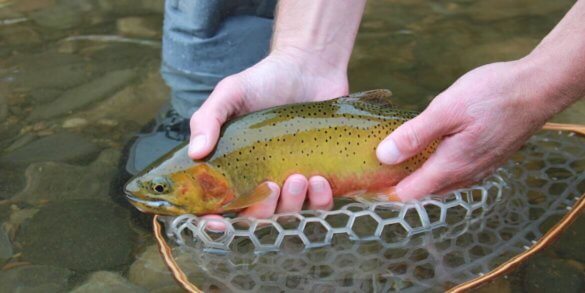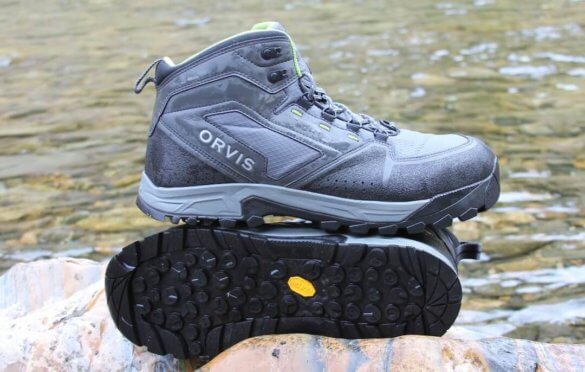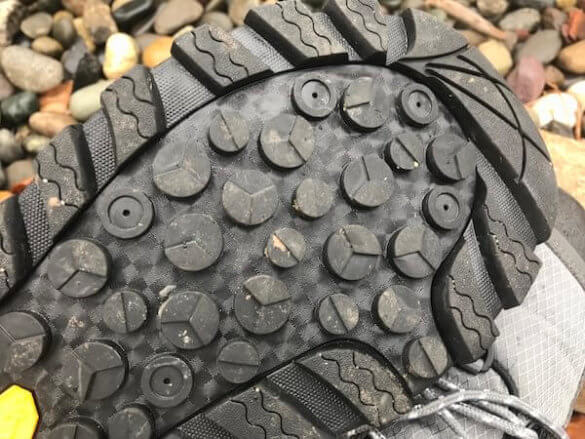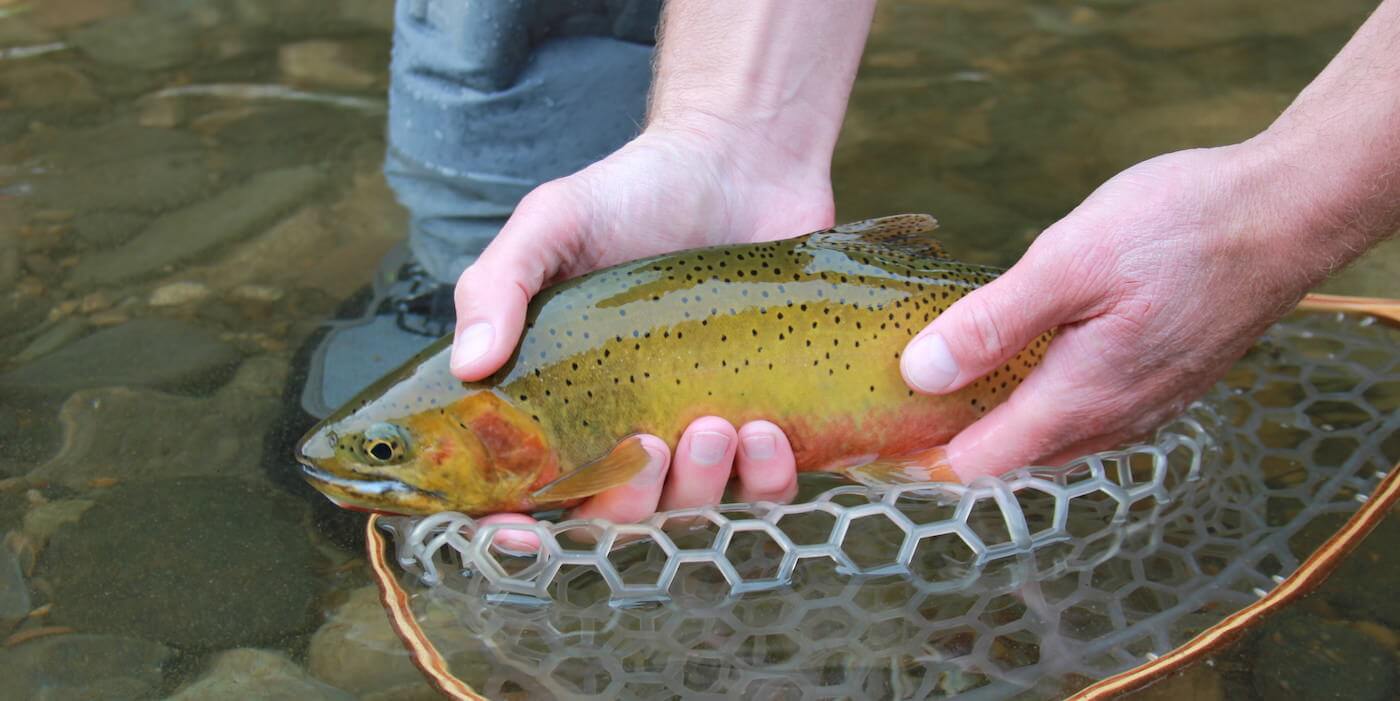The Orvis Ultralight Wading Boots are part of the Orvis Ultralight Wading System. They’re aimed at frequent travelers and more active fly fishers who like to cover a lot ground or hike into fishing spots off the beaten path.
To get us a closer look, Orvis sent Man Makes Fire a review pair. After testing the Ultralight Wading Boots while fly fishing in Idaho rivers, this is what we learned:
Orvis Ultralight Wading Boots Review
I’m not a fan of tall and heavy wading boots, so I was pleased to see that the Orvis Ultralight Wading Boots have a lower ankle height. They’re higher than a typical mid-height hiking boot but 1.5-to-2 inches lower than most wading boots — and that’s a fantastic start in my book. In fact, the Orvis Ultralight Wading Boots are in our guide to the 10 Best Wading Boots for 2022.

The Orvis Ultralight Wading Boots are one of the most nimble wading boots available today. I had no trouble hiking hundreds of yards down to a river and climbing around large boulders and rip-rap. Bottom line, the Orvis Ultralight Wading Boots are one of the most effective overland scrambling wading boots I’ve ever worn.
Orvis Ultralight Wading Boots Review: Weight and Feel

So how did Orvis make these boots so light and nimble?
The exterior blends synthetic materials to build a boot that’s lighter than traditional leather. In fact, Orvis says the boot’s Clarino microfiber exterior provides a better strength-to-weight ratio than leather. That’s a tough metric to test over time, but the Orvis Ultralight Wading Boots seem to be plenty strong. I only have a couple miles into testing these boots so far, but after skidding down steep rocky banks and tromping through brush and over deadfalls, I can barely find a scuff anywhere.
Orvis also added an abrasion-resistant rubber spray coating to high-wear areas around the toe and heel. It’s thinner and lighter than full rubber rands you might find on other boots. The structure of the boot, with the ripstop nylon panels, blends support with flexibility.
The Vibram EVA midsole offers great cushioning while a TPU plate adds stability to the sole and offers improved stud retention (more on studs later).
The total package comes together in a boot that is lighter than most other wading boots. Compared to other size 14 wading boots, the Orvis Ultralight Wading Boots ranged from being 4 ounces lighter (per pair) up to a whopping 26 ounces lighter than the heaviest wading boots I tested.
Orvis Ultralight Wading Boots Review: Perfect?
With all this gushing, you might think the Orvis Ultralight Wading Boots are perfect. They’re not.
First of all, let’s talk sizing. To get the right Orvis size wading boot, you take your street shoe size then size up. For example, if you wear a size 12 you would buy a size 13 Orvis wading boot. That means that if you’re a true size 14 in your regular shoe size, you need to order a size 15 from Orvis — but Orvis only makes a size 15 in its Clearwater Wading Boots. (I’m a 13.5 shoe size but no one makes half sizes that big.)
How do they fit?

When paired with typical stockingfoot waders — including the excellent Orvis Ultralight Convertible Waders — the Orvis Ultralight Wading Boots fit true to size. The toe box is roomy, so the snugness and length should be doable for most people.
I like to pair the Orvis Ultralight Wading Boots with a lightweight neoprene wading sock, which are usually a bit thinner than standard stockingfoot wader booties, they’re downright awesome.
How about ankle support? For me, they have plenty of ankle support, and they lace up tightly without trouble. (If you have weak ankles, though, you probably want to error on the side of a taller wading boot like the Orvis PRO Wading Boots.)
Orvis Ultralight Wading Boots Review: Traction
On dry ground, the Orvis Ultralight Wading Boots have the best traction I’ve ever experienced in a wading boot. I was seriously amazed as I climbed steep banks, scrambled over boulders and leaped from driftwood tangles to stream-side boulders. I’m not the smartest of fly fishers when it comes to choosing my path, and as I age, I’m not as nimble as I used to be. On the ground, the Orvis Ultralight Wading Boots seriously impressed me. Orvis has accomplished something special with its use of a dual durometer Vibram outsole and proprietary Orvis lug pattern.

All that said, in-the-water traction was about average. Maybe slightly better than average for rubber-soled wading boots, but certainly not stellar compared to felt. For small rocky bottoms, sand and gravel, I wouldn’t bother putting studs in the soles. If you’re wading among slick watermelon-sized and larger rocks over varied underwater terrain and fast water . . . you’ll want to install the Orvis PosiGrip Screw-in Studs.
What about felt? Orvis is not offering a felt version of these boots. I’m not sure why, but it might have something to do with the fear that felt could be more conducive to the transfer of invasive species between waterways — and lightweight boots are more likely to be selected for fly fishing travel. (If you want to learn more, some states in the U.S., along with Yellowstone National Park, have banned the use of felt-soled wading boots.)
The Verdict
The Orvis Ultralight Wading Boots are one of the best wading boots I’ve taken fishing in the last decade. The rubber soles are fantastic on the trail, on boulders and river banks. For smaller creek fishing, lake shore fishing and rivers that have primarily gravel or sandy bottoms, the rubber soles will work well. For wading in challenging waters, you can amp up the wet traction with screw-in studs. All-in-all, if you’re looking for a light and nimble wading boot, the Orvis Ultralight Wading Boots should be on your shortlist. Very highly recommended.
Get the Gear:
- Orvis Ultralight Wading Boots – Men’s
- Orvis Ultralight Wading Boots – Women’s





